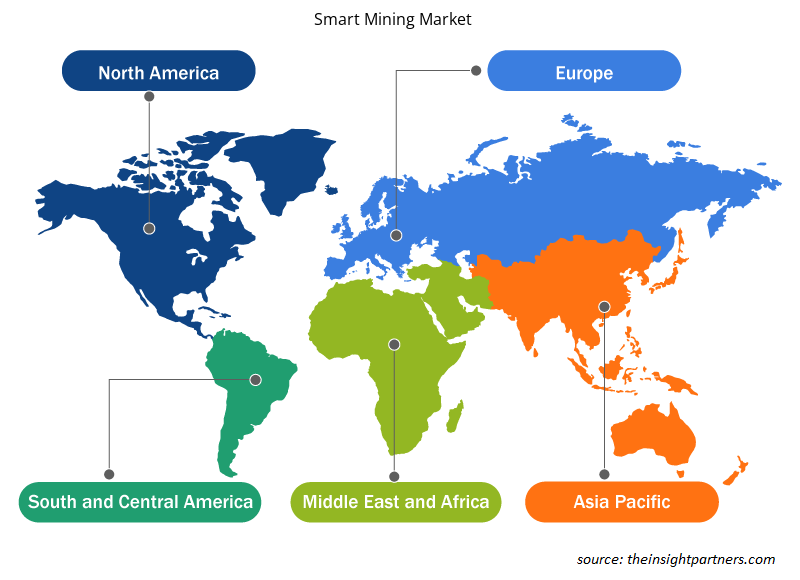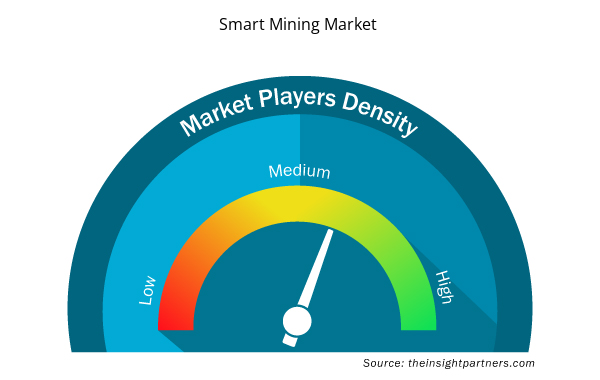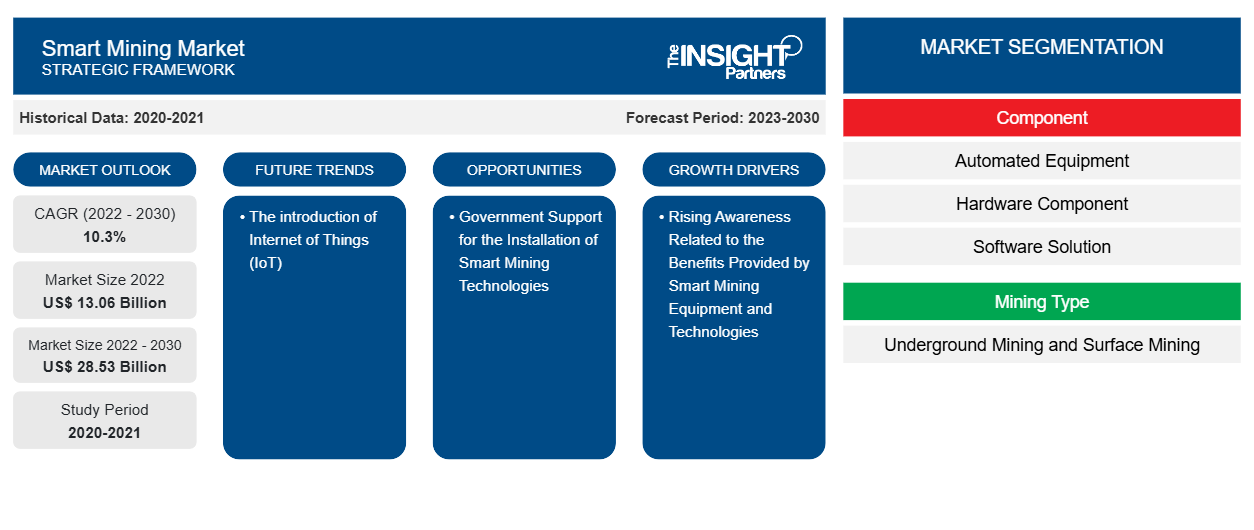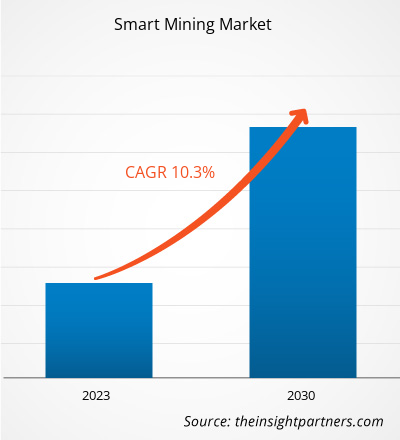Der Markt für Smart Mining wurde im Jahr 2022 auf 13,06 Milliarden US-Dollar geschätzt und soll bis 2030 28,53 Milliarden US-Dollar erreichen. Der Markt für Smart Mining wird von 2022 bis 2030 voraussichtlich eine durchschnittliche jährliche Wachstumsrate (CAGR) von 10,3 % verzeichnen. Die Einführung des Internets der Dinge (IoT) dürfte ein wichtiger Trend auf dem Markt bleiben.
Smart Mining Marktanalyse
Das steigende Bewusstsein für die Vorteile intelligenter Bergbauausrüstung und -technologien und die wachsende Notwendigkeit, die Sicherheit der Arbeitnehmer zu gewährleisten, treiben den Markt an. Es wird erwartet, dass der Markt im Prognosezeitraum wachsen wird, da die Nachfrage der Unternehmen nach intelligenten Bergbaukomponenten zur Verbesserung der Datensicherheit steigt. Darüber hinaus schaffen die staatliche Unterstützung für die Installation intelligenter Bergbautechnologien und die zunehmende Einführung automatisierter Bergbauausrüstung lukrative Möglichkeiten für den Markt.
Smart Mining Marktübersicht
Smart Mining bezeichnet den Einsatz vernetzter Technologien im Bergbau. Zu diesen Technologien gehören Kameras, Sensoren und Drohnen, die über das Internet miteinander und mit ihrer Umgebung kommunizieren. Gerätenetzwerke helfen dabei, Prozesse zu automatisieren, Abläufe zu vereinfachen, Daten zu sammeln und verschiedene Abschnitte des Bergbauprozesses zu verbinden. Smart-Mining-Technologie hilft Bergwerken, die Effizienz zu steigern, Geld zu sparen, die Sicherheit der Arbeiter zu gewährleisten und die Umweltverschmutzung zu reduzieren.
Passen Sie diesen Bericht Ihren Anforderungen an
Sie erhalten kostenlos individuelle Anpassungen an jedem Bericht, einschließlich Teilen dieses Berichts oder einer Analyse auf Länderebene, eines Excel-Datenpakets sowie tolle Angebote und Rabatte für Start-ups und Universitäten.
- Holen Sie sich die wichtigsten Markttrends aus diesem Bericht.Dieses KOSTENLOSE Beispiel umfasst eine Datenanalyse von Markttrends bis hin zu Schätzungen und Prognosen.
Treiber und Chancen des Smart Mining-Marktes
Steigendes Bewusstsein für die Vorteile intelligenter Bergbauausrüstung und -technologien zur Förderung des Marktes
Die Welt erforscht intelligente Bergbautechnologien, um ihre Bergbauindustrie zu verbessern. Das Wachstum bei der Digitalisierung und industriellen Automatisierung hilft Bergbauunternehmen, ihre Betriebseffizienz zu verbessern. Diese Vorteile helfen dem Land, seine Bergbauaktivitäten auszuweiten. So kündigte die italienische Regierung im Jahr 2023 die Wiederaufnahme des Bergbaus kritischer Rohstoffe an. Die Mine enthält zahlreiche Materialien wie Lithium, Kobalt, Nickel, Kupfer, Zink, Beryllium und Wolfram. Die Regierung schätzt auch, dass das Land mindestens 15 der 34 Elemente im Boden hat. Die Wiederaufnahme der Bergbauaktivitäten erfordert intelligente Geräte und Technologien, um den Bergbaubetrieb zu rationalisieren. Diese intelligenten Bergbautechniken helfen den Arbeitern, ihre Produktivität zu steigern, indem sie die Umweltbelastung minimieren.
Staatliche Unterstützung für die Einführung intelligenter Bergbautechnologien
Die Regierung hat außerdem in mehr als 1.000 aktiven Kohlekraftwerken intelligente Bergbautechnologien installiert, um die jährliche Produktionskapazität auf über 620 Millionen Tonnen zu steigern. Darüber hinaus modernisiert das Land seine Kohlekraftwerke, indem es die „intelligente Mine“ Hongliulin im Kohlegürtel der Provinz Shaanxi einsetzt, um den Spitzenwert der Treibhausgasemissionen bis 2030 zu senken. Die Nachhaltigkeitsvorteile intelligenter Bergbautechnologien beflügeln den Markt im Land. Daher dürfte die zunehmende Zahl von Aufklärungsprogrammen, Konferenzen, Ausstellungen usw. im Prognosezeitraum Wachstumschancen auf dem Markt für intelligentes Bergbau schaffen.
Segmentierungsanalyse des Smart Mining-Marktberichts
Wichtige Segmente, die zur Ableitung der Smart-Mining-Marktanalyse beigetragen haben, sind Komponente und Bergbautyp.
- Basierend auf den Komponenten ist der Smart-Mining-Markt in automatisierte Geräte, Hardwarekomponenten, Softwarelösungen und Dienstleistungen unterteilt. Das Segment der automatisierten Geräte ist in Lastkipper, Roboter-LKW, Bohrer und Brecher, Bagger und andere unterteilt. Das Segment der Hardwarekomponenten ist in RFID-Tags, Sensoren, intelligente Systeme und andere unterteilt. Das Segment der Softwarelösungen ist in Logistiksoftware und -lösungen, Daten- und Betriebsmanagementsoftware und -lösungen, Sicherheitssysteme, Konnektivitätslösungen, Analyselösungen, Fernverwaltungslösungen und Asset-Management-Lösungen unterteilt. Das Segment der automatisierten Geräte hatte im Jahr 2022 einen größeren Marktanteil.
- Auf der Grundlage der Bergbauart wird der Markt in Untertagebau und Tagebau unterteilt. Das Segment Untertagebau hatte im Jahr 2022 einen größeren Marktanteil.
Smart Mining Marktanteilsanalyse nach Geografie
Der geografische Umfang des Smart-Mining-Marktberichts ist hauptsächlich in fünf Regionen unterteilt: Nordamerika, Asien-Pazifik, Europa, Naher Osten und Afrika sowie Süd- und Mittelamerika.
Der Markt in Europa dürfte im Prognosezeitraum aufgrund der wachsenden Zahl von Bergbauaktivitäten wachsen. So startete Imerys Mining im Oktober 2022 das Projekt EMILI (Imerys‘ Lithium Mica Mining Project), um Lithium in Frankreich abzubauen. Das Projekt wird ab 2028 jährlich 34.000 Tonnen Lithiumhydroxid produzieren, was die industrielle Souveränität Frankreichs und Europas stärkt und die Produktion von Lithiumbatterien steigert. Die Projekte helfen Imerys Mining, seine Fähigkeiten im Bereich der Energiewende zu integrieren und zu verbessern, um den mit Bergbauaktivitäten verbundenen CO2-Fußabdruck zu reduzieren. Beim Lithiumabbau werden oft autonome Fahrzeuge und Robotersysteme eingesetzt, um die Effizienz und Sicherheit der Minen zu erhöhen. Die zunehmende Einführung intelligenter Bergbautechnologien in Frankreich dürfte den Markt ankurbeln.
Regionale Einblicke in den Smart Mining-Markt
Die regionalen Trends und Faktoren, die den Smart Mining-Markt im Prognosezeitraum beeinflussen, wurden von den Analysten von Insight Partners ausführlich erläutert. In diesem Abschnitt werden auch die Marktsegmente und die Geografie des Smart Mining-Marktes in Nordamerika, Europa, im asiatisch-pazifischen Raum, im Nahen Osten und Afrika sowie in Süd- und Mittelamerika erörtert.

- Holen Sie sich die regionalspezifischen Daten für den Smart Mining-Markt
Umfang des Smart Mining-Marktberichts
| Berichtsattribut | Details |
|---|---|
| Marktgröße im Jahr 2022 | 13,06 Milliarden US-Dollar |
| Marktgröße bis 2030 | 28,53 Milliarden US-Dollar |
| Globale CAGR (2022 - 2030) | 10,3 % |
| Historische Daten | 2020-2021 |
| Prognosezeitraum | 2023–2030 |
| Abgedeckte Segmente | Nach Komponente
|
| Abgedeckte Regionen und Länder | Nordamerika
|
| Marktführer und wichtige Unternehmensprofile |
|
Dichte der Akteure im Smart Mining-Markt: Auswirkungen auf die Geschäftsdynamik verstehen
Der Smart Mining-Markt wächst rasant, angetrieben durch die steigende Nachfrage der Endnutzer aufgrund von Faktoren wie sich entwickelnden Verbraucherpräferenzen, technologischen Fortschritten und einem größeren Bewusstsein für die Vorteile des Produkts. Mit steigender Nachfrage erweitern Unternehmen ihr Angebot, entwickeln Innovationen, um die Bedürfnisse der Verbraucher zu erfüllen, und nutzen neue Trends, was das Marktwachstum weiter ankurbelt.
Die Marktteilnehmerdichte bezieht sich auf die Verteilung der Firmen oder Unternehmen, die in einem bestimmten Markt oder einer bestimmten Branche tätig sind. Sie gibt an, wie viele Wettbewerber (Marktteilnehmer) in einem bestimmten Marktraum im Verhältnis zu seiner Größe oder seinem gesamten Marktwert präsent sind.
Die wichtigsten auf dem Smart-Mining-Markt tätigen Unternehmen sind:
- ABB Ltd
- Alastri
- Caterpillar Inc
- Intellisense.io
- Hexagon AB
- Hitachi GmbH
Haftungsausschluss : Die oben aufgeführten Unternehmen sind nicht in einer bestimmten Reihenfolge aufgeführt.

- Überblick über die wichtigsten Akteure auf dem Smart Mining-Markt
Neuigkeiten und aktuelle Entwicklungen zum Smart Mining-Markt
Der Smart-Mining-Markt wird durch die Erhebung qualitativer und quantitativer Daten nach Primär- und Sekundärforschung bewertet, die wichtige Unternehmensveröffentlichungen, Verbandsdaten und Datenbanken umfasst. Nachfolgend sind einige der Entwicklungen auf dem Smart-Mining-Markt aufgeführt:
- Der führende Bergbaukonzern hat in der Mine 740 km nordöstlich von Perth das ABB Ability Operations Management System & (OMS 41;) implementiert. Das OMS trägt zur digitalen Transformation des Granny Smith-Betriebs von GoldField bei und zielt darauf ab, die Produktivität zu verbessern und den Datenfluss zu optimieren, um zeitnahe Entscheidungen zu ermöglichen. Aus der unterirdischen Mine werden jährlich etwa 1,6 Millionen Tonnen goldhaltiges Erz gefördert und in der Verarbeitungsanlage des Standorts behandelt. (Quelle: ABB Ltd, Unternehmenswebsite, September 2023)
Abdeckung und Ergebnisse des Smart Mining-Marktberichts
Der Bericht „Smart Mining-Marktgröße und -prognose (2020–2030)“ bietet eine detaillierte Analyse des Marktes, die die folgenden Bereiche abdeckt:
- Smart Mining-Marktgröße und -prognose auf globaler, regionaler und Länderebene für alle wichtigen Marktsegmente, die im Rahmen des Berichts abgedeckt sind
- Smart Mining-Markttrends sowie Marktdynamik wie Treiber, Einschränkungen und wichtige Chancen
- Detaillierte PEST/Porters Five Forces- und SWOT-Analyse
- Analyse des Smart-Mining-Marktes mit wichtigen Markttrends, globalen und regionalen Rahmenbedingungen, wichtigen Akteuren, Vorschriften und aktuellen Marktentwicklungen
- Branchenlandschaft und Wettbewerbsanalyse, einschließlich Marktkonzentration, Heatmap-Analyse, prominenten Akteuren und aktuellen Entwicklungen für den Smart-Mining-Markt
- Detaillierte Firmenprofile
- Historische Analyse (2 Jahre), Basisjahr, Prognose (7 Jahre) mit CAGR
- PEST- und SWOT-Analyse
- Marktgröße Wert/Volumen – Global, Regional, Land
- Branche und Wettbewerbsumfeld
- Excel-Datensatz


- Grant Management Software Market
- Molecular Diagnostics Market
- Educational Furniture Market
- Artwork Management Software Market
- Artificial Intelligence in Defense Market
- Bioremediation Technology and Services Market
- Bathroom Vanities Market
- Visualization and 3D Rendering Software Market
- Flexible Garden Hoses Market
- Sodium Bicarbonate Market

Report Coverage
Revenue forecast, Company Analysis, Industry landscape, Growth factors, and Trends

Segment Covered
This text is related
to segments covered.

Regional Scope
North America, Europe, Asia Pacific, Middle East & Africa, South & Central America

Country Scope
This text is related
to country scope.
Häufig gestellte Fragen
The global smart mining market is expected to reach US$ 28.53 billion by 2030.
The key players holding majority shares in the global smart mining market are ABB Ltd, Alastri, Caterpillar Inc, Intellisense.io, Hexagon AB, Hitachi Ltd, MineSense, Rockwell Automation Inc, SAP SE, and Trimble Inc.
Asia Pacific dominated the smart mining market in 2022.
The global smart mining market is estimated to register a CAGR of 10.3% during the forecast period 2022–2030.
Growing demand and adoption of consumer electronics products among consumers Rising awareness related to the benefits provided by smart mining equipment and technologies and the growing need to keep the workforce safe are the major factors that propel the global smart mining market.
The introduction of the Internet of Things (IoT) to play a significant role in the global smart mining market in the coming years.
Trends and growth analysis reports related to Electronics and Semiconductor : READ MORE..
The List of Companies - Smart Mining Market
- ABB Ltd
- Alastri
- Caterpillar Inc
- Intellisense.io
- Hexagon AB
- Hitachi Ltd
- MineSense
- Rockwell Automation Inc
- SAP SE
- Trimble Inc
The Insight Partners performs research in 4 major stages: Data Collection & Secondary Research, Primary Research, Data Analysis and Data Triangulation & Final Review.
- Data Collection and Secondary Research:
As a market research and consulting firm operating from a decade, we have published and advised several client across the globe. First step for any study will start with an assessment of currently available data and insights from existing reports. Further, historical and current market information is collected from Investor Presentations, Annual Reports, SEC Filings, etc., and other information related to company’s performance and market positioning are gathered from Paid Databases (Factiva, Hoovers, and Reuters) and various other publications available in public domain.
Several associations trade associates, technical forums, institutes, societies and organization are accessed to gain technical as well as market related insights through their publications such as research papers, blogs and press releases related to the studies are referred to get cues about the market. Further, white papers, journals, magazines, and other news articles published in last 3 years are scrutinized and analyzed to understand the current market trends.
- Primary Research:
The primarily interview analysis comprise of data obtained from industry participants interview and answers to survey questions gathered by in-house primary team.
For primary research, interviews are conducted with industry experts/CEOs/Marketing Managers/VPs/Subject Matter Experts from both demand and supply side to get a 360-degree view of the market. The primary team conducts several interviews based on the complexity of the markets to understand the various market trends and dynamics which makes research more credible and precise.
A typical research interview fulfils the following functions:
- Provides first-hand information on the market size, market trends, growth trends, competitive landscape, and outlook
- Validates and strengthens in-house secondary research findings
- Develops the analysis team’s expertise and market understanding
Primary research involves email interactions and telephone interviews for each market, category, segment, and sub-segment across geographies. The participants who typically take part in such a process include, but are not limited to:
- Industry participants: VPs, business development managers, market intelligence managers and national sales managers
- Outside experts: Valuation experts, research analysts and key opinion leaders specializing in the electronics and semiconductor industry.
Below is the breakup of our primary respondents by company, designation, and region:

Once we receive the confirmation from primary research sources or primary respondents, we finalize the base year market estimation and forecast the data as per the macroeconomic and microeconomic factors assessed during data collection.
- Data Analysis:
Once data is validated through both secondary as well as primary respondents, we finalize the market estimations by hypothesis formulation and factor analysis at regional and country level.
- Macro-Economic Factor Analysis:
We analyse macroeconomic indicators such the gross domestic product (GDP), increase in the demand for goods and services across industries, technological advancement, regional economic growth, governmental policies, the influence of COVID-19, PEST analysis, and other aspects. This analysis aids in setting benchmarks for various nations/regions and approximating market splits. Additionally, the general trend of the aforementioned components aid in determining the market's development possibilities.
- Country Level Data:
Various factors that are especially aligned to the country are taken into account to determine the market size for a certain area and country, including the presence of vendors, such as headquarters and offices, the country's GDP, demand patterns, and industry growth. To comprehend the market dynamics for the nation, a number of growth variables, inhibitors, application areas, and current market trends are researched. The aforementioned elements aid in determining the country's overall market's growth potential.
- Company Profile:
The “Table of Contents” is formulated by listing and analyzing more than 25 - 30 companies operating in the market ecosystem across geographies. However, we profile only 10 companies as a standard practice in our syndicate reports. These 10 companies comprise leading, emerging, and regional players. Nonetheless, our analysis is not restricted to the 10 listed companies, we also analyze other companies present in the market to develop a holistic view and understand the prevailing trends. The “Company Profiles” section in the report covers key facts, business description, products & services, financial information, SWOT analysis, and key developments. The financial information presented is extracted from the annual reports and official documents of the publicly listed companies. Upon collecting the information for the sections of respective companies, we verify them via various primary sources and then compile the data in respective company profiles. The company level information helps us in deriving the base number as well as in forecasting the market size.
- Developing Base Number:
Aggregation of sales statistics (2020-2022) and macro-economic factor, and other secondary and primary research insights are utilized to arrive at base number and related market shares for 2022. The data gaps are identified in this step and relevant market data is analyzed, collected from paid primary interviews or databases. On finalizing the base year market size, forecasts are developed on the basis of macro-economic, industry and market growth factors and company level analysis.
- Data Triangulation and Final Review:
The market findings and base year market size calculations are validated from supply as well as demand side. Demand side validations are based on macro-economic factor analysis and benchmarks for respective regions and countries. In case of supply side validations, revenues of major companies are estimated (in case not available) based on industry benchmark, approximate number of employees, product portfolio, and primary interviews revenues are gathered. Further revenue from target product/service segment is assessed to avoid overshooting of market statistics. In case of heavy deviations between supply and demand side values, all thes steps are repeated to achieve synchronization.
We follow an iterative model, wherein we share our research findings with Subject Matter Experts (SME’s) and Key Opinion Leaders (KOLs) until consensus view of the market is not formulated – this model negates any drastic deviation in the opinions of experts. Only validated and universally acceptable research findings are quoted in our reports.
We have important check points that we use to validate our research findings – which we call – data triangulation, where we validate the information, we generate from secondary sources with primary interviews and then we re-validate with our internal data bases and Subject matter experts. This comprehensive model enables us to deliver high quality, reliable data in shortest possible time.


 Holen Sie sich ein kostenloses Muster für diesen Bericht
Holen Sie sich ein kostenloses Muster für diesen Bericht